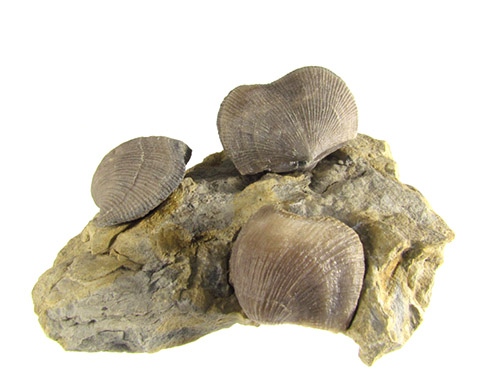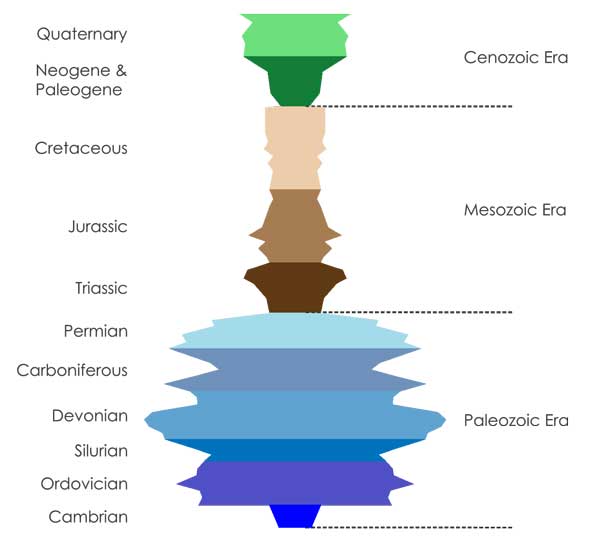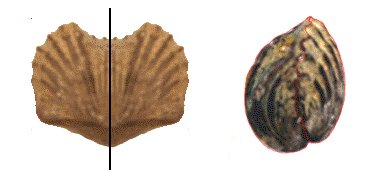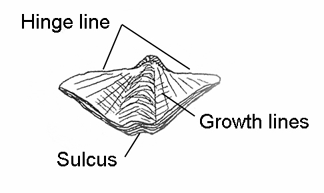Sign up for Lesson Plans, discounts & more!
Brachiopods:
Bivalves With A Past

Brachiopods are benthic (bottom dwelling), marine (ocean), bivalves (having two shells). They are considered living fossils, with 3 orders present in today’s oceans. They are rare today but during the Paleozoic Era they dominated the sea floors.
Though they appear to be similar to clams or oysters they are not related. They are not even mollusks. They belong to the phylum Lophophorata and are related to bryozoans.
The Pedicle
One characteristic unique to brachiopods is the pedicle. It is a long thin fleshy appendage. The pedicle is used to burrow into the sea floor as an anchor.
Some Brachiopods have a muscular pedicle. They can raise themselves up off the bottom, looking like they are standing on their heads. For others it is more like a tether.
Not all orders have a pedicle. Some lay on the sand on one side. With these the bottom shell is usually larger than the top shell. There are even some types that cement themselves to the ocean floor.
What’s for Dinner?
All members of this phylum are filter feeders. They feast upon microscopic organisms and bits of organic matter.
This they gather from the water that flows by them with a specialized organ called a lophophore. This is a tube like structure with cilia (hair like projections). The cilia move food particles down the lophophore to the mouth.
The lophophore takes up about 2/3 of the space inside the shell, with the body of the animal occupying the remaining third.
The Valves
The two shells are each symmetrical about the midline but they are most often not equal to each other.
In contrast clams are asymmetrical about the midline with each valve or shell equal mirror images of each other.
Each valve or shell has its own name. The valve that the pedicle is attached to is called, surprisingly enough the pedicle valve. It is usually the larger of the two and has the pedicle opening.
The other valve holds the lophophore or brachia and of course is called the brachial valve. The lophophore is supported by a calcerous structure called the brachidium.
This structure varies greatly in complexity from a simple loop to a
double spiraled coil. The shape of the brachidium is important in
determining brachiopod classification.
There is usually a central raised area on the pedicle valve called a fold with a corresponding depression on the brachial valve called the sulcus.

Geologic History
Brachiopods have a long geologic history. They have been around since the Cambrian Period. Look at the spindle graph on the right. The width of the spindle represents the numbers and diversity of species of brachiopods through time. The earliest time is at the bottom of the spindle. Recent time is at the top. It is easy to see that the Paleozoic Era was a time that favored the brachiopods. From the Ordovician Period through the Permian Period they were abundant in genera and shear numbers. The Permian extinctions reduced their numbers severely.
Several orders survived the extinction but brachiopods have never regained the abundance they enjoyed during the Paleozoic Era. However, they may be the most plentiful fossil on earth. They are used as index fossils.
Learn about how brachiopods are classified
Try our Brachiopods Crossword Puzzle
Or Wordsearch Puzzle
Are you looking to buy brachiopods? Fossilicious.com has many species of Brachiopods For Sale.
Check out some of the Educational Materials for sale on our sister site fossilicious.com.

interested in more? If so, you may want to check out our other sites:
fossilicious.com - Our online fossil and mineral rock shop.
rocksandminerals4u.com - An educational site about rocks, minerals, and geology.
Geologic Time Geologic Time Line
Cenozoic Era
Quaternary
Neogene
Paleogene
Mesozoic Era
Cretaceous
Jurassic
Triassic
Paleozoic Era
Permian
Carboniferous
Devonian
Silurian
Ordovician
Cambrian
Archean Time
Hadean Time
Teachers Resources
Activities for Education and Fun
Earth Science Lesson Plans
Activities For Kids
Fossil Lesson Plans
Fossil Activities
Education Articles
Coloring Pages
Dinosaur Coloring Pages
Montessori Materials
Geology Club
Fossil Hunting
 |
 |
 |






